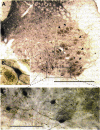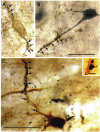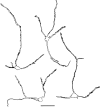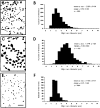Distribution of cholinergic contacts on Renshaw cells in the rat spinal cord: a light microscopic study
- PMID: 10066905
- PMCID: PMC2269191
- DOI: 10.1111/j.1469-7793.1999.787ab.x
Distribution of cholinergic contacts on Renshaw cells in the rat spinal cord: a light microscopic study
Abstract
1. Cholinergic terminals in the rat spinal cord were revealed by immunohistochemical detection of the vesicular acetycholine transporter (VAChT). In order to determine the relationships of these terminals to Renshaw cells, we used dual immunolabelling with antibodies against gephyrin or calbindin D28k to provide immunohistochemical identification of Renshaw cells in lamina VII of the ventral horn. 2. A total of 50 Renshaw cells were analysed quantitatively using a computer-aided reconstruction system to provide accurate localization of contact sites and determination of somatic and dendritic surface area. Dendrites could be traced for up to 413 microm from the soma in calbindin D28k-identified Renshaw cells and up to 184 microm in gephyrin-identified cells. 3. A total of 3330 cholinergic terminals were observed on 50 Renshaw cells, with a range of 21-138 terminal appositions per cell (mean 66.6 +/- 25.56 contacts per cell). The vast majority (83.5 %) of the terminals were apposed to dendrites rather than the soma. The overall density of cholinergic contacts increased from a little above 1 per 100 microm2 on the soma and initial 25 microm of proximal dendrites to 4-5 per 100 microm2 on the surface of dendritic segments located 50-250 microm from the soma. Single presynaptic fibres frequently formed multiple contacts with the soma and/or dendrites of individual Renshaw cells. 4. VAChT-immunoreactive terminals apposed to Renshaw cells varied in size from 0.6 to 6.9 microm in diameter (mean 2.26 +/- 0.94; n = 986) and were on average smaller than the cholinergic C-terminals apposed to motoneurones, but larger than VAChT-immunoreactive terminals contacting other ventral horn interneurones. 5. The high density and relatively large size of many cholinergic terminals on Renshaw cells presumably correlates with the strong synaptic connection between motoneurones and Renshaw cells. The fact that the majority of contacts are distributed over the dendrites makes the motoneurone axon collateral input susceptible to inhibition by the prominent glycinergic inhibitory synapses located on the soma and proximal dendrites. The relative positions and structural features of the excitatory cholinergic and inhibitory glycinergic synapses may explain why Renshaw cells, although capable of firing at very high frequency following motor axon stimulation, appear to fire at relatively low rates during locomotor activity.
Figures







References
-
- Alvarez FJ, Harrington DA, Dewey DE, Fyffe REW. Cell-type specific organization of glycine receptor clusters in the mammalian spinal cord. Journal of Comparative Neurology. 1997;379:150–170. 10.1002/(SICI)1096-9861(19970303)379:1<150::AID-CNE10>3.3.CO;2-M. - DOI - PubMed
-
- Alvarez FJ, Pearson JC, Harrington DA, Dewey DE, Torbeck L, Fyffe REW. Distribution of 5-hydroxytryptamine-immunoreactive boutons on α-motoneurons in the lumbar spinal cord of adult cats. Journal of Comparative Neurology. 1998;393:69–83. 10.1002/(SICI)1096-9861(19980330)393:1<69::AID-CNE7>3.3.CO;2-X. - DOI - PubMed
-
- Arvidsson U, Reidl M, Elde R, Meister B. Vesicular acetylcholine transporter (VAChT) protein: A novel and unique marker for cholinergic neurons in the central and peripheral nervous systems. Journal of Comparative Neurology. 1997;378:454–467. 10.1002/(SICI)1096-9861(19970224)378:4<454::AID-CNE2>3.3.CO;2-5. - DOI - PubMed
-
- Binder MD, Heckman CJ, Powers RK. The physiological control of motoneuron activity. In: Rowell LB, Shepherd JT, editors. Handbook of Physiology, section 12, Exercise: Regulation and Integration of Multiple Systems. New York, Oxford: American Physiological Society; 1996. pp. 3–53.
Publication types
MeSH terms
Substances
Grants and funding
LinkOut - more resources
Full Text Sources

